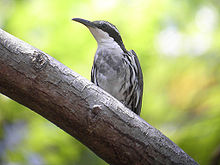Type a search term to find related articles by LIMS subject matter experts gathered from the most trusted and dynamic collaboration tools in the laboratory informatics industry.
| Philippine creepers | |
|---|---|

| |
| Stripe-headed rhabdornis (Rhabdornis mystacalis) | |
| Scientific classification | |
| Domain: | Eukaryota |
| Kingdom: | Animalia |
| Phylum: | Chordata |
| Class: | Aves |
| Order: | Passeriformes |
| Suborder: | Passeri |
| Family: | Sturnidae |
| Genus: | Rhabdornis Reichenbach, 1853 |
| Type species | |
| Meliphaga mysticalis Temminck, 1825
| |
| Species | |
|
Rhabdornis grandis | |
The Philippine creepers or rhabdornises are small passerine birds and form the genus Rhabdornis. They are endemic to the Philippines. They do not migrate, other than to make local movements.
The genus Rhabdornis was introduced in 1853 by German naturalist Ludwig Reichenbach to accommodate the stripe-headed rhabdornis.[1] The name combines the Ancient Greek rhabdos meaning "stripe" with ornis meaning "bird."[2]
The relationship of the Philippine creepers to other bird species was formerly uncertain and the genus Rhabdornis was placed in its own family Rhabdornithinae.[3][4] Molecular phylogenetic studies have revealed that the Philippine creepers are aberrant members of the starling family Sturnidae.[5][6][7]
The genus contains four species:[8]
The Philippine creepers are similar in appearance to treecreepers (Certhiidae). They have thin pointed down-curved bills, which they can use to extricate insects from bark, but they have brush-like tongues, which enable them to also feed on nectar.